Abstract
Henna is the powdered leaf of Lawsonia Inermis, and has been widely used as a dye for the skin, hair and nails. Black henna is composed of henna itself with p-phenylenediamine (PPD) and used for temporary black henna tattoos. The PPD compound of the henna transforms the harmless henna to an allergenic material and generalized erythema multiforme, Sweet’s syndrome, acquired leucoderma, urticaria and angioneurotic edema are the other reported rare complications of black henna tattoos. Localized hypertrichosis on the temporary henna tattoo is not a usual side effect and there are a few reports about this topic. The common point of these cases is disappearance of the hypertrichosis within 4-5 months. Notwithstanding the fact that the treatment is not certainly necessary, it could be a problem for some patients because of its cosmetic concern. This case is an example of localized hypertrichosis after henna tattoo and treated immediately with 755 nm Alexandrite Laser in one session.
Details
| Journal Section | Internal Medical Sciences |
|---|---|
| Authors | |
| Publication Date | July 3, 2017 |
| Submission Date | April 11, 2015 |
| Published in Issue | Year 2016 Volume: 33 Issue: 4 |
Cite

This work is licensed under a Creative Commons Attribution-NonCommercial 4.0 International License.


